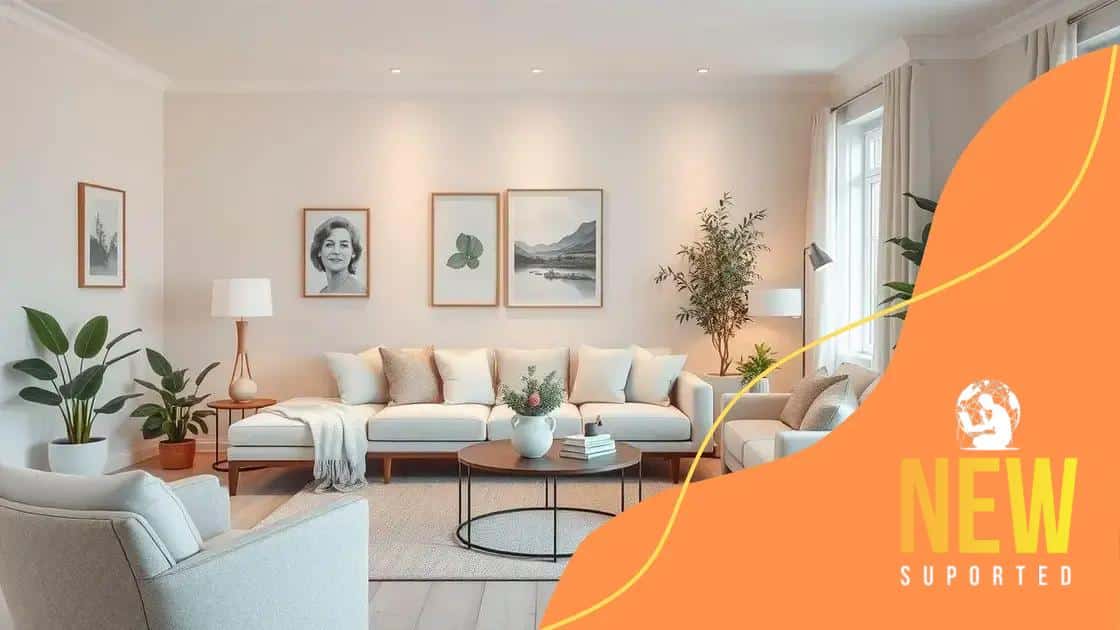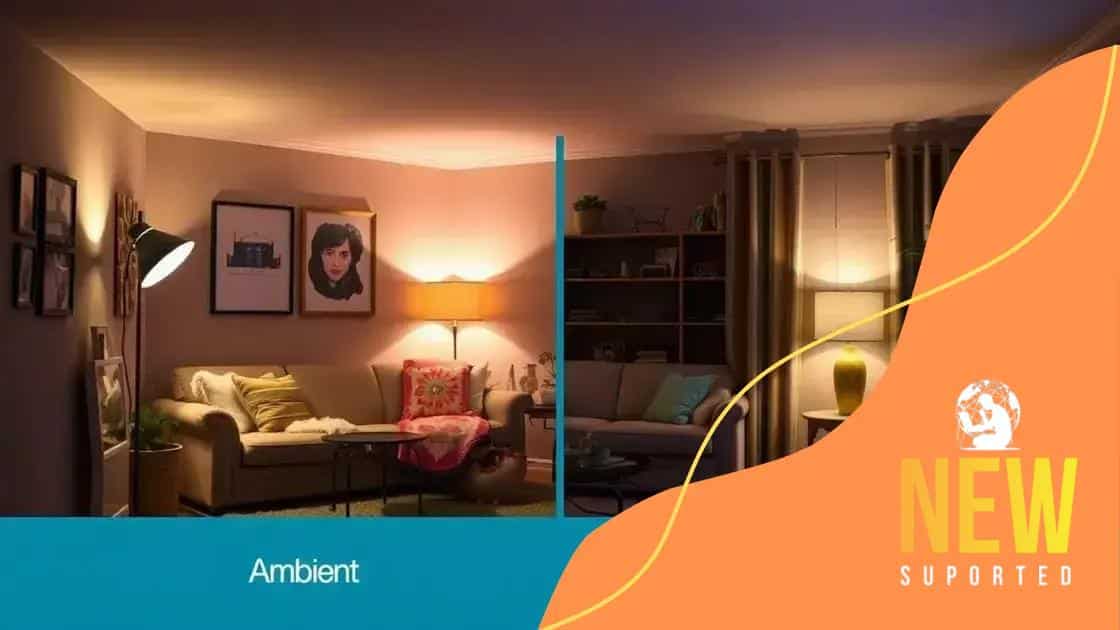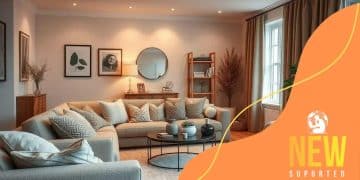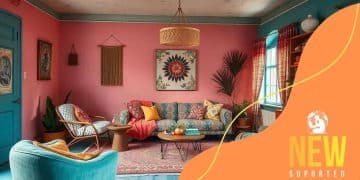Color schemes for creating a calming home atmosphere

Color schemes for creating a calming home atmosphere should include soft hues like blue and green, complemented by natural textures and layered lighting to enhance relaxation and tranquility.
Color schemes for creating a calming home atmosphere play a crucial role in how we feel in our spaces. Have you ever noticed how certain colors can instantly soothe or energize? Let’s dive into how to create that serene vibe in your home.
Understanding color psychology
Understanding color psychology is important for creating a soothing environment. Colors can influence our emotions and behavior, making it essential to choose the right shades for your home. For instance, warm colors like red and orange can energize a space, whereas cooler shades like blue and green tend to evoke feelings of peace and tranquility.
The emotional effects of colors
Each color has its own meaning and can elicit specific feelings. By incorporating these hues into your decor, you can manipulate the mood of a room. Here are some common associations:
- Blue: Calming and serene, often used in bedrooms.
- Green: Refreshing and revitalizing, ideal for living areas.
- Yellow: Cheerful and uplifting, great for kitchens.
- Purple: Luxurious and spiritual, perfect for reading nooks.
Using these colors thoughtfully can enhance your home’s atmosphere. Consider how different colors might interact with the natural light in a room or how they can complement your furniture. For instance, soft pastels can create an inviting ambiance, while bold colors may create a dramatic effect.
Applying color psychology in your space
To effectively apply color psychology, start by assessing how you want to feel in each room. Take time to consider the purpose of the space as well as the emotions you wish to inspire. For example, if you want a *workspace* to feel both motivating and calming, you might choose a mix of blue and green tones. This combination can foster creativity while keeping you relaxed.
It’s also important to think about how colors work together. A balanced palette not only makes a space visually pleasing but also promotes a sense of harmony. You can achieve this by limiting your color choices to a few complementary tones.
Ultimately, understanding color psychology enables you to create a home that reflects your personality and supports your emotional well-being. By intentionally selecting colors that resonate with you, you can curate spaces that are as calming as they are beautiful.
Best color combinations for relaxation
When it comes to achieving a relaxing home atmosphere, certain color combinations stand out. These hues not only promote calmness but can also transform your space into a peaceful retreat. Choosing the right colors is key to creating a soothing environment.
Top color combinations
Here are some of the best color combinations for relaxation:
- Soft blue and white: This combination evokes a serene beach vibe, promoting tranquility and freshness.
- Light green and beige: Earthy tones can create a balanced atmosphere, connecting you with nature and enhancing feelings of peace.
- Pale lavender and pale gray: These soft colors blend nicely, creating a calm and elegant space that fosters relaxation.
- Warm taupe and dusty rose: A cozy palette that feels welcoming and soothing, perfect for a quiet nook or bedroom.
Using these color combinations wisely can enhance your mood and promote serenity. Consider how they interact with natural light and existing furniture. For example, a soft blue accent wall paired with white furnishings can make a room feel open and breezy.
Creating harmony with accents
In addition to primary color choices, incorporating accents in complementary tones can further enhance relaxation. Adding cushions, throws, or artwork in shades of your main colors can tie the room together, creating visual harmony. Gentle accents in colors like pastel pink or light mint can add warmth without overwhelming the senses.
Another important factor is to keep the overall tone balanced. Too many vibrant colors can create chaos, whereas a well-thought-out palette can lead to a restful ambiance. Think about how each color interacts and supports your desired atmosphere. Ultimately, the best color combinations for relaxation are those that resonate with you personally, creating a space where you can unwind and recharge.
How lighting affects your color choices

Lighting plays a crucial role in how colors appear in your home. Different types of lighting can dramatically change the perception of color, affecting the overall atmosphere of a room. Understanding how lighting affects your color choices can help you create a calming environment.
Types of lighting
There are three main types of lighting to consider:
- Ambient lighting: This is the main source of light in a room. It creates a soft and overall glow. Colors might appear lighter and cooler under this lighting.
- Task lighting: Used for specific tasks, like reading or cooking. This lighting can bring out the vibrancy of colors, making them look brighter and more defined.
- Accent lighting: Used to highlight specific features, such as artwork or architectural details. It can enhance certain colors and create focal points in your space.
By understanding these lighting types, you can better choose colors that will work harmoniously in your environment. For example, a warm ambient light can make cooler colors like blue and green feel even more tranquil.
Testing colors under different lights
Before committing to paint colors or fabrics, it’s wise to test them in various lighting conditions. As daylight changes throughout the day, colors can shift. A color that seems perfect in the morning sunlight may look drastically different under the soft glow of a lamp in the evening.
Consider using color swatches and placing them around the room to see how they interact with the light at different times. This practice can help you find the perfect hue that maintains its calming quality, regardless of the lighting.
Ultimately, by paying attention to how lighting affects your color choices, you can create a cohesive and inviting space. Thoughtfully selected colors, paired with the right lighting, can promote relaxation and enhance your home’s atmosphere.
Using textures to enhance colors
Using textures to enhance colors is an effective way to create depth and interest in your home decor. Textures can influence how colors are perceived, adding richness to a room. By combining different textures, you can make a color scheme feel more dynamic and inviting.
The role of textures
Textures can make colors pop. For example, a smooth, shiny surface can reflect light and enhance a color’s vibrancy. In contrast, a matte finish can soften a color, making it feel more subdued and comforting. Consider these common textures:
- Soft fabrics: Cushions, throws, and curtains made from plush materials like velvet or cotton add warmth and softness.
- Wood surfaces: Wooden furniture and accents can bring warmth to cooler color shades, enhancing their overall appeal.
- Metals: Incorporating metals like brass or chrome can add a modern touch, giving colors a sleek and sophisticated look.
- Rugs: A textured rug can anchor a room and provide contrast against smoother surfaces, creating a balanced aesthetic.
Each texture contributes to the overall sensory experience of the room. By mixing and matching materials, you can achieve a visually appealing contrast that elevates your color choices.
Practical tips for using textures
To effectively use textures in your home, start by selecting a base color palette. Once you have your colors, think about how you can layer different textures. For example, if you have a calming blue wall, consider adding a soft cream sofa, a woven blanket, and decorative metal lamps to enhance the overall look. This layering technique not only provides depth but also keeps the space feeling inviting.
Pay attention to how light interacts with these textures. A textured wall can create shadows that shift throughout the day, enhancing the dynamic quality of your chosen colors. Ultimately, using textures to enhance colors allows you to craft a space that feels multi-dimensional and resonates with your personal style.
Tips for maintaining a calming atmosphere
Maintaining a calming atmosphere in your home involves several key practices. By focusing on elements like color, lighting, and decor, you can create a space that promotes relaxation and well-being. It’s all about finding the right balance to foster tranquility.
Organizing your space
One of the first steps in creating a calming environment is decluttering. A clean, organized space can instantly make you feel more at ease. Consider implementing these tips:
- Regularly declutter: Make it a habit to remove items that no longer serve a purpose.
- Use storage solutions: Baskets and boxes can help keep things tidy and out of sight.
- Limit decor: Choose a few meaningful pieces instead of overcrowding surfaces with items.
By organizing your space, you not only create a visual calm but also mentally prepare yourself for relaxation.
Incorporating calming elements
To enhance your home’s calming atmosphere, consider integrating soothing elements. Natural materials and plants can make a significant difference. Adding features like:
- Plants: Indoor plants can improve air quality and reduce stress.
- Soft fabrics: Incorporating pillows and throws made of natural fibers can create a cozy feel.
- Gentle scents: Use essential oil diffusers or scented candles to provide pleasant aromas without overwhelming the senses.
These elements work together to create an inviting and peaceful environment. Choosing a harmonious color palette also plays a key role in setting the mood. Stick to soft hues like pastels or earth tones to enhance the calming effect.
Finally, pay attention to sound. Consider using soft music or white noise machines to mask disruptive noises from outside. These small adjustments help maintain that tranquil atmosphere throughout your home.
In conclusion, creating a calming home atmosphere involves thoughtful choices in color, lighting, and decor. By organizing your space, utilizing soothing colors and textures, and paying attention to lighting, you can cultivate an environment that fosters relaxation. Remember to incorporate natural elements and minimize clutter for a peaceful vibe. These simple steps can transform your home into a tranquil retreat where you can unwind and recharge.
FAQ – Frequently Asked Questions about Creating a Calming Home Atmosphere
What colors are best for creating a calming atmosphere?
Soft hues like blue, green, and pastel tones are excellent for promoting relaxation and peace in your home.
How can lighting impact the feel of my space?
Lighting can dramatically change how colors are perceived, with ambient, task, and accent lighting all playing a role in creating a calming environment.
What are some effective ways to declutter my home?
Regularly removing items that no longer serve a purpose and using storage solutions can help keep your space organized and serene.
How can I incorporate natural elements into my decor?
Using indoor plants, natural materials, and light fabrics can enhance the calming effect of your home while also improving air quality.






